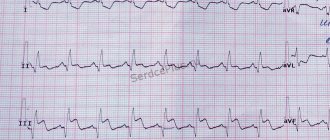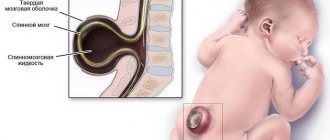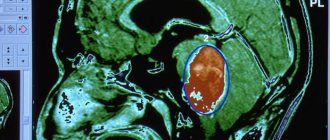The cause of its occurrence will be congenital diseases or stress.
In critical situations, such crises are possible.
Find the answer
Are you having any problem? Enter “Symptom” or “Name of the disease” into the form, press Enter and you will find out all the treatment for this problem or disease.
The site provides reference information. Adequate diagnosis and treatment of the disease is possible under the supervision of a conscientious doctor. Any medications have contraindications. Consultation with a specialist is required, as well as detailed study of the instructions! Here you can make an appointment with a doctor.
Why does the disease occur?
The causes of vagoinsular crisis are not fully understood, although it is known for certain that neurocircular (vegetative-vascular) dystonia has a significant influence on its development.
Every second patient with VSD experiences crises from time to time. Healthy people are much less susceptible to this condition. Doctors identify several main reasons:
- Head injuries;
- Drinking alcohol and smoking;
- Unbalanced diet;
- Osteochondrosis of the cervical spine;
- Mental, emotional and physical overload;
- Pathologies of the nervous system;
- Diseases of the heart and cardiovascular system (eg, autonomic dysfunction of the heart);
- Hereditary predisposition;
- Diseases of the endocrine system (hyperthyroidism, hypothyroidism, diabetes mellitus, etc.);
- Personality characteristics (hypochondria, increased anxiety);
- Caffeine abuse;
- Severe infectious diseases;
- Mental disorders;
- Neuroses.
Possible complications of the crisis
If vagoinsular crises occur repeatedly, a full examination should be performed. These conditions are dangerous to health.
Severe hemodynamic disorders can lead to disruption of blood supply to the heart muscle, brain and other organs.
Complications of a crisis include pathologies such as heart attack and stroke, cardiogenic shock, acute renal failure, and hypoglycemic coma. All of these conditions can be fatal. Therefore, it is important to eliminate the causes of vagotonia.
Diagnostics
If vegetative-vascular dystonia is suspected, the doctor usually prescribes a comprehensive examination due to the variety of symptoms. Only this approach helps to understand in detail the causes of the disease and methods of its treatment. What is important here is differential diagnosis, which allows one to exclude organic pathology. If VSD is suspected, the patient undergoes consultation with a neurologist, endocrinologist and cardiologist.
Identifying risk factors
Finding out the patient's medical history, the doctor establishes a family history of autonomic dysfunction. It is important if one of your close relatives has a stomach ulcer, bronchial asthma, hypertension, coronary heart disease, hyperthyroidism, or diabetes mellitus. In childhood, vegetative-vascular dystonia can be aggravated by recurrent focal infections - both acute and chronic.
Assessment of the state of the autonomic system
To prescribe effective treatment for vegetative-vascular dystonia, it is necessary to assess the initial autonomic tone (at rest) and determine indicators of autonomic reactivity. For this purpose, the patient’s complaints are analyzed, and an EEG (electroencephalography) of the brain is also performed. Autonomic reactions are verified through various functional tests.
Cardiovascular research
Since the causes of the disease are directly related to the condition of the blood vessels, in order to prescribe the correct treatment for vegetative-vascular dystonia, it may be necessary to undergo Doppler ultrasound of the vessels (neck, brain). It is also possible that your doctor will order an ECG (electrocardiogram).
It is highly recommended not to refuse treatment for vegetative-vascular dystonia, no matter how insignificant the chosen method may seem to you. If the doctor considers it necessary to prescribe therapy, complete the entire course - do not neglect your own health.
Nocturnal paroxysms
Nocturnal paroxysmal dystonia is a separate type of vegetative attacks that does not fit into the traditional classification. Unlike other forms of pathology, the causes of its origin are still unknown.
The problem manifests itself as episodes of chaotic motor activity involving the limbs and the whole body after waking up.
Clinically, nocturnal paroxysm of dystonia resembles an epileptic seizure, but with normal electroencephalography (EEG) readings. It is believed that the reason for the appearance of such movements is the loss of inhibitory mechanisms in the brain stem.
Normally, they interfere with human muscle activity during sleep. The pathology is manifested by characteristic seizures. The average episode length is 10–60 minutes. Treatment has not yet been developed.
Diencephalic crisis
Rich symptoms are characteristic of diencephalic crisis, which is based on lesions of the hypothalamus as a result of:
- Hormonal disorders;
- Exposure to toxic substances;
- Chronic traumatic environment;
- Development of the tumor process;
- Traumatic brain injury and other adverse factors.
In its manifestations, this type is in many ways similar to the vagoinsular type, however, signs of a sympathetic-adrenal crisis also occur. Diencephalic paroxysm is characterized by:
- The rapid development of events, where the patient’s condition worsens, as they say, “before our eyes”;
- Severe vegetative symptoms;
- Pain in the heart and rapid heartbeat;
- Feeling of suffocation;
- Fluctuations in blood pressure and pulse rate;
- Pallor or hyperemia of the face;
- Bluish discoloration of the limbs;
- Pain in the epigastric region, dry mouth, thirst;
- Increased body temperature (possibly up to 39 degrees);
- Chills followed by a feeling of heat;
- Increased urination, sweating;
- Excitement, anxiety, fear of death.
After an attack, the patient usually feels weak and drowsy.
Symptoms
Due to the fact that in this paroxysm inhibition processes predominate, the disease has a number of the following specific symptoms:
- Before an attack and at its very beginning, the patient becomes weak, his vision becomes dark, and he feels dizzy.
- As the paroxysmal state develops, a decrease in the heart rate (heart rate) to 40-50 beats/min, sweating, difficulty breathing and/or shortness of breath, a decrease in blood pressure, and a decrease in body temperature may be noted. There is a frequent urge to defecate, culminating in vomiting that does not bring relief. In rare cases, a person loses consciousness.
- Often, vagoinsular crisis is accompanied by various disturbances of cardiac activity: arrhythmias, extrasystoles, increased cardiac output, etc.
- After a crisis, which can last up to 1-2 hours, as a rule, sweating remains, accompanied by anxiety and fear of death, headache, shortness of breath, pain and discomfort in the peritoneum. Sometimes the attack repeats after 10-20 minutes. This condition is called undulating vagoinsular crisis.
Treatment and prognosis
In patients with vegetative-vascular dystonia, treatment is carried out under the supervision of doctors of the following specializations: therapist, neurologist, endocrinologist, psychiatrist. Certain prescriptions will depend on the predominant symptoms of VSD. Usually, taking into account the nature and etiology of the disease, complex long-term individual therapy is carried out.
Physical therapy classes
Special physical education is most useful in the treatment of VSD in both adults and children. Such exercises have a general strengthening effect and are an excellent way to train the whole body and improve performance. Designed for the treatment of VSD and thought out taking into account age and health status, physical therapy should also exclude jumping. In general, an active lifestyle can be an integral component of the prevention of vegetative-vascular dystonia.
Undergoing physical therapy
Therapeutic massage, water treatments, and reflexology also have a positive effect in the treatment of VSD. The physiotherapeutic effect is selected depending on the type of disease: it can be electrophoresis with calcium or caffeine (in the case of vagotonia) or with magnesium, papaverine or bromine (for the treatment of sympathicotonia).
Use of drug treatment
If general strengthening and physiotherapeutic measures are insufficient for the effective treatment of VSD, the specialist individually selects drug therapy, which may include the following drugs:
- sedatives that reduce the activity of autonomic reactions, antidepressants, nootropics;
- beta-blockers and herbal psychostimulants that help reduce vegetative-vascular manifestations;
- Vitamin-mineral complexes usually have a beneficial general strengthening effect.
If necessary, to treat various forms of VSD, a course of therapy is also carried out aimed at eliminating chronic foci of infection, concomitant endocrine or somatic pathology. The doctor regularly monitors a patient with vegetative-vascular dystonia. Clinical examination may be prescribed (every 3-6 months), especially in the autumn-spring period.
Reasons for the development of the pathological condition
There are many reasons why a vagoinsular crisis may develop. Among them are both endo- and exogenous influences.
Most often, the pathological condition develops against the background of nervous tension. Vagoinsular crises are also observed with changes in the endocrine and cardiovascular systems.
After all, all organs are interconnected through innervation. The causes of the crisis include:
- Brain injuries.
- Vascular disorders. Most often they occur against the background of cervical osteochondrosis and increased blood pressure.
- Neurotic conditions.
- Excessive emotional and physical stress.
- Vegetative-vascular dystonia caused by complicated heredity.
- Pathologies of the thyroid gland.
- Diabetes.
- Cardiac diseases.
- Mental disorders.
- Severe intoxication of the body.
Vagoinsular crisis in childhood develops due to complications of childbirth and pregnancy. People exposed to head injuries during infancy are prone to vegetative-vascular dystonia. Paroxysms caused by increased insulin levels in the blood often occur in children whose parents suffer from vagotonia.
Mysterious vagoinsular crisis: how to identify and treat VSD?
When the regulation of vascular tone by the autonomic nervous system is disturbed, neurocirculatory dystonia develops; one of the manifestations is vagoinsular crisis. Its occurrence is associated with activation of the parasympathetic department and manifests itself in the form of an attack of falling blood pressure, blood glucose levels and increased intestinal motility (“bear disease”).
Tonic drugs are used for treatment, physiotherapy is effective as preventive measures, and folk remedies are also used.
Causes of vagoinsular crisis
The immediate factor provoking a crisis is an increase in the tone of the vagus nerve - vagotonia. The reasons for the activation of the parasympathetic nervous system can be:
- traumatic brain injuries, including birth injuries;
- lack of oxygen during intrauterine development;
- stressful conditions, experiences;
- infectious diseases;
- low physical activity;
- diabetes mellitus, usually type 2;
- obesity;
- age-related hormonal changes - puberty, menopause;
- mental stress;
- diseases of the digestive system;
- climate change.
We recommend reading the article about neurocirculatory dystonia. From it you will learn about the causes of the pathology, its types and symptoms, diagnostics and treatment methods, and preventive measures.
And here is more information about arterial hypotension.
Symptoms
Typical signs of high tone of the parasympathetic system are:
- constriction of the pupils;
- intense secretion of saliva and gastric juice;
- drop in pressure in arterial vessels;
- slow heart rate;
- narrowing of the bronchi;
- stimulation of bile secretion;
- contraction of the bladder;
- relaxation of the intestines;
- increased secretion of digestive enzymes and insulin by the pancreas.
Therefore, a vagoinsular crisis is accompanied by general weakness, dizziness and faintness (a drop in blood pressure and glucose), difficulty breathing, pain in the intestines and the urge to defecate.
Patients note a flush of heat, a freezing heartbeat, a throbbing headache, an attack of hunger, and trembling hands.
The duration of the attack can vary from several minutes to 2 - 3 hours. Their frequency of occurrence reflects the severity of neurocirculatory dystonia. Most often, such crises develop in spring and autumn.
In children, manifestations include allergic reactions and sudden suffocation, which are regarded as harbingers of bronchial asthma. Vagotonic reactions in childhood are characterized by increased sweating, sensitivity to cold and stuffiness, and frequent respiratory diseases.
After the crisis, a period of asthenia begins. Patients experience severe fatigue, sleep disturbances, and intolerance to loud sounds, bright lights, and smells. The mood level is low, it is difficult to concentrate on mental activity, and physical activity is weakened. Children are extremely restless, capricious and tearful.
Watch the video about neurocirculatory dystonia and its manifestations:
Diagnostics
When examining patients, redness of the skin, red dermographism is noted (when carried out with a thin stick, a red mark is left), blood pressure and pulse rate are reduced, and the ECG may show single extrasystoles against the background of bradycardia. The blood test shows hypoglycemia (low sugar levels).
To exclude diseases that occur with similar symptoms, consultations with a neurologist and endocrinologist are indicated.
Treatment in children and adults
When treating vagoisular crises, tactics can be chosen depending on the frequency and severity of attacks and the presence of underlying diseases.
Drug treatment
Prescribed during the interictal period to normalize the tone of the parasympathetic nervous system. For this purpose use:
- means for improving metabolic processes in the brain - Nootropil, Glycine, Glutamic acid, Picamilon, Pantogam;
- tonic preparations - tinctures or extracts of adaptogens (Eleutherococcus, Rhodiola rosea, Schisandra, ginseng), Pantocrine, Tonginal;
- vitamin complexes – Neurobeks Neo, Milgamma.
Lifestyle correction
When treating vegetative-vascular dystonia, normalizing lifestyle is no less important and effective than taking medications. To successfully get rid of vagotonia and crises, it is recommended:
- a clear eating schedule, frequency of at least 5 - 6 times;
- healthy foods - lactic acid drinks, oatmeal and buckwheat porridge, dried fruits, fresh juices, honey, pollen, green tea, nuts;
- sufficient sleep;
- daily walks;
- hardening;
- physical activity in the form of therapeutic exercises, Pilates, swimming, yoga;
- limit watching TV, staying at the computer;
- contrast shower, dousing with cool water;
- baths with sea salt.
Physiotherapy
Water treatment is widely used for vagoisular crises - hydromassage, pine baths, as well as oxygen and pearl baths. Showers are prescribed jet and circular.
Treatment with water jets
Electrophoresis with calcium chloride, mesatone or caffeine is recommended for the cervical-collar area. For the electrosleep procedure, the pulse frequency is selected at a feed rate of 20 - 40 per second. Darsonvalization of the scalp and cervical spine is indicated.
Prevention
Timely detection, treatment and consistent prevention lead to the disappearance or significant reduction of the main manifestations of vegetative-vascular dystonia (in 80-90% of cases). A full range of measures allows you to restore the body’s adaptive capabilities. A significant role in this is played by lifestyle correction, which includes normalizing the work regime, eliminating physical inactivity, providing daily dosed physical activity, limiting excessive emotional influences, and proper nutrition.
An integral component of the prevention of vegetative-vascular dystonia is rest. It is extremely important to travel outside the city regularly. The best option would be to undergo treatment in a sanatorium, a stay in which not only allows you to fully relax from constant physical and psycho-emotional stress, but also provides the opportunity to undergo special procedures in one place.
If you are looking for a way to effectively treat and prevent VSD or want to undergo a comprehensive examination, contact the ABC-Medicine clinic. To contact specialists, dial our Moscow number.
Sympathoadrenal crisis
One can expect a variety of manifestations from vegetative paroxysm, therefore the symptoms of a vegetative-vascular crisis will depend on which department holds primacy, that is, the clinical signs will determine the type of paroxysm. Let's say the symptoms of a sympathoadrenal crisis will be as follows:
- Increased blood pressure;
- Sharp, sudden chills;
- Headache and tachycardia, which may become paroxysmal;
- Frequent urination with a significant amount of urine released;
- In some cases, there is a rise in body temperature;
- Dry mouth;
- Feeling of inexplicable anxiety and fear of death.
This crisis could have been provoked by mental and physical overload, stress, and changes in weather.
Symptoms
Due to the fact that in this paroxysm inhibition processes predominate, the disease has a number of the following specific symptoms:
- Before an attack and at its very beginning, the patient becomes weak, his vision becomes dark, and he feels dizzy.
- As the paroxysmal state develops, a decrease in the heart rate (heart rate) to 40-50 beats/min, sweating, difficulty breathing and/or shortness of breath, a decrease in blood pressure, and a decrease in body temperature may be noted. There is a frequent urge to defecate, culminating in vomiting that does not bring relief. In rare cases, a person loses consciousness.
- Often, vagoinsular crisis is accompanied by various disturbances of cardiac activity: arrhythmias, extrasystoles, increased cardiac output, etc.
- After a crisis, which can last up to 1-2 hours, as a rule, sweating remains, accompanied by anxiety and fear of death, headache, shortness of breath, pain and discomfort in the peritoneum. Sometimes the attack repeats after 10-20 minutes. This condition is called undulating vagoinsular crisis.
Causes of vascular crisis
The main cause of vascular crisis is considered to be characteristic disorders in vascular tone. In this case, the processes of regulation of the nervous and humoral nature of this tone are disrupted. In addition, many diseases can influence the formation of various types of vascular crises.
As a rule, these include hypertension, various pathological processes occurring in peripheral vessels, as well as in the central nervous system.
In addition, the formation of a vascular crisis is facilitated by some diseases in which vasoactive substances, that is, hormones in the form of aldosterone, serotonin, adrenaline, etc., are excessively released into the blood vessels.
Characteristic etiological factors that provoke the appearance of a vascular crisis may be inflammatory processes in blood vessels, frostbite, and atherosclerosis. All these reasons lead to changes in the sensitivity of the walls of blood vessels and the receptor apparatus.
Impaired hemodynamics is also considered one of the reasons for the development of vascular crisis. This mainly concerns coartation of the aorta, since it is characterized by narrowing in the isthmus region of the aorta itself and is a congenital pathology.
Features of the flow
Treatment of vegetative paroxysms is complex. It is carried out using both specialized drugs (mainly affecting the functioning of the ANS) and non-drug methods:
- acupuncture;
- aromatherapy;
- physiotherapy;
- meditation.
By fixing the factor that provokes the appearance of the next paroxysm, with its further elimination, it is possible to normalize the person’s condition.
It is possible to completely eliminate the occurrence of attacks by normalizing the balance between the branches of the autonomic system and increasing the threshold of excitability of the nervous system.
Risk factors for crisis development
Despite the fact that almost all people are exposed to nervous and physical stress, vagoinsular crises develop only in a certain part of the population. This is due to a hereditary predisposition to this condition, which is of great importance. More often, vegetative-vascular dystonia is diagnosed in young women.
Risk factors include characteristics of the human psyche, nutrition, the presence of bad habits, concomitant pathological conditions, lifestyle, etc. Crises can occur in the following cases:
- In the presence of constant nervous tension. For example, due to heavy mental work.
- If a person keeps emotions to himself for a long time, that is, he is an introvert.
- In people prone to obesity. Hypercholesterolemia is a risk factor for vagotonia.
- With caffeine abuse.
- In cases where an anxious or hypochondriacal personality type is formed.
Vagoinsular crisis refers to acute conditions in which it is necessary to provide emergency care to the patient. Every doctor should know what therapeutic measures to take to stop an attack.
Urgent Care
It is important to immediately call an ambulance when an attack occurs.
This is the only way to prevent further deterioration of the situation. First aid should be provided to the patient. You need to lay it on a flat and soft surface. You need to unbutton collars and buttons so that nothing is squeezing your body. So that the breathing rhythm does not become difficult or disturbed.
The patient needs fresh air, apply cold to the body.
To avoid panic, you need to try to calm the patient down. It is important to prevent a nervous breakdown from the symptoms of a crisis.
As first emergency aid, it is appropriate to give a person clonidine - in drops or tablets. Validol, valerian, and valocordin should be added to the list of necessary medications. One of these medications should be given to the patient before the ambulance arrives.











